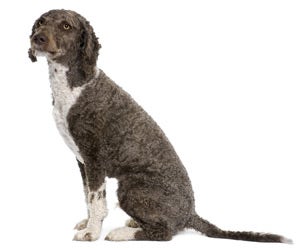American Water Spaniel
-
Overview
American Water Spaniels are a rare breed, but they are the state dog of Wisconsin and enjoy plenty of popularity in the Midwestern United States, where they are used for all-weather water retrieving. They stand between 15 and 18 inches tall and weigh between 25 and 45 pounds.
-
Personality
American Water Spaniels should demonstrate their intelligence and eagerness through their interactions with people. They are friendly dogs who should be tolerant of other people. Some are suspicious or stand-offish around other dogs, so make sure to socialize your dog from a young age to help them become polite around new dogs. American Water Spaniels are athletic dogs who were bred for endurance rather than speed. Although they can swim for extensive amounts of time, they never move outrageously fast.
American Water Spaniels love to be the center of attention. They can be demanding of affection and attention. If they feel they are being treated harshly or unfairly, they can become stubborn and use their strong-willed natures to manipulate their owners. They are slow to mature and can be possessive as puppies, so train them to share their territory and space with other members of the household.
-
Coat Care
American Water Spaniels have water-resistant double coats with a protective under layer and a crisp, curly or wavy outer layer. The coat is generally uniformly curly or wavy. Their coats come in shades of brown. Their long ears are covered in curls and their face is covered in soft, short hair. Their long, feathered tail curves upward and works as a rudder while they swim. The coat is oily to the touch, so it can give off an odor. The ears are covered in hair, but the hair should not grow into the ears.

Brush your American Water Spaniel's coat weekly with a slicker brush to remove any debris and keep the texture and appearance looking its best. Frequent brushing will help reduce seasonal shedding.
With preparation, perseverance and a positive attitude, bathing can become a fun and fulfilling part of the regular grooming cycle, while helping your dog avoid many diseases and infections.
Breeds with combination coats should be bathed seasonally, or about every three months. Naturally, it can be done more often if needed. The coat should end up fresh smelling, with no loose or shedding hair. First give the dog a good brushing to remove dead hair and mats. Place a rubber mat in the tub to provide secure footing and fill the tub with three to four inches of lukewarm water. Use a spray hose, pitcher or unbreakable cup to wet the dog, taking caution to avoid getting water in the eyes, ears and nose. Massage in pet shampoo, saving the head for last. Immediately rinse thoroughly, starting with the head to prevent soap from dripping into the eyes. Towel dry. Coat should be fresh smelling, with no loose or shedding hair.
Owners who use American Water Spaniels for hunting sometimes clip their coats to make it easier for them to work in tough terrain. Trimming the coat and shaving the ears every six weeks will help your dog stay tidy and comfortable.
Many dog owners are apprehensive about trimming their dog’s nails because they are nervous about cutting into the quick. But with the right conditioning and careful cutting, nail clipping can be a simple, stress-free activity for you and your dog.
Provide your dog with plenty of positive reinforcement and even treats to help associate nail clipping with a positive experience. As you start to clip, gently press on your dog’s paws to help him become accustomed to the feeling of having his nails clipped. Then, work gradually, shaving down just a thin portion of the nail at first to make sure you don’t reach the quick. Clip one nail, reward your dog with a treat, and stop to give him some positive reinforcement before moving on. Gradually increase the number of nails you clip in one sitting to help your dog get used to the process. Never trim extremely long nails down to a short nail in one sitting, because this is an excellent way to accidently quick the dog’s nail. Instead, work gradually, shaving small portions of your dog’s nails off each time.
You can tell if you’re getting close to the quick by the texture of your dog’s nail. The nail is hard closer to the surface and becomes softer as you get closer to the quick. If your dog’s nail starts to feel softer, that’s a good indication that you’re getting close to the quick.
Make sure to check the ears weekly to prevent hair from growing inside and becoming painful or infected.
Many owners do not realize how important it is to brush your pet’s teeth on a regular basis. Some dogs are prone to dental problems and sensitive teeth, especially small dogs with tiny teeth and dogs with special diets. These problems can be easily combatted with frequent brushing.
Cavities are rare with dogs but gum disease caused by tartar buildup is not, which is why they require regular brushing with toothpaste and a toothbrush formulated specifically for dogs. While daily brushing is ideal, doing so on a weekly basis will be a big help in avoiding the need to bring your dog to a veterinarian for a cleaning, which usually has to be done under sedation.

 India (English)
India (English)
 Middle East and Africa (English)
Middle East and Africa (English)
 South Africa (English)
South Africa (English)
 Australia (English)
Australia (English)
 Japan (日本語)
Japan (日本語)
 South East Asia (English)
South East Asia (English)
 Singapore (English)
Singapore (English)
 Europe (English)
Europe (English)
 United Kingdom (English)
United Kingdom (English)
 Argentina (Español)
Argentina (Español)
 Brazil (Portuguese)
Brazil (Portuguese)
 Colombia (Español)
Colombia (Español)
 Latin America (Español)
Latin America (Español)
 México (Español)
México (Español)
 Chile (Español)
Chile (Español)
 Peru (Español)
Peru (Español)
 Canada (English)
Canada (English)

